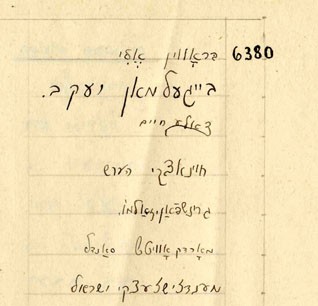
Chaim Benzion Cale
The Jewish children of Lodz suffered unfolding harsh realities after the German invasion of Poland. Some of the children, among them Chaim Benzion Cale, recorded their experiences in diaries. Their voices offer a view into the struggle of a community and its young to live in spite of the most difficult circumstances.
Excerpts
“We were scared of all of it. We were scared of Jewish policemen. We were scared of Biebow. We were scared of Rumkowski. We were scared of Sonderkommando. We were scared—always we were scared.” —Chaim Cale, age 13
I wanted to go to school not so much to learn, but to eat the soup and not be frozen.” —Chaim Cale, age 13
Chaim's Story
Chaim Benzion Cale was born in October 1927. His stepmother Bajla loved him like her own son. Chaim's family was quite well off. The father and his family were in the meat delivery business.
After the German invasion of Poland, Chaim's grandfather was severely beaten by soldiers and died soon after. Chaim was 12 years old.
Chaim's father insisted on keeping the Jewish tradition and made sure that Chaim had a Bar Mitzvah in October 1940. Chaim attended elementary school number 13B in the Lodz ghetto. In the fall of 1941 he was asked by the teacher to help out and draw the greeting page for the Rosh Ha'shana album for the Chairman of the Jewish Council, Mordechai Chaim Rumkowski. He remembers drawing the shadowed Stars of David.
A year later, during the Gehsperre Aktion, Chaim was hidden behind a huge wardrobe together with other people, including a young couple with a small baby. During the search of the building by the Germans, they all kept very quiet and the young parents kept a blanket over the baby's mouth. After the search was over they discovered that the baby was dead. The next day the couple gave themselves up for deportation.
After the schools were closed, Chaim worked in a metal workshop in the ghetto. In August 1944, Chaim and his parents were deported to Auschwitz-Birkenau. His mother was killed on arrival. Chaim and his father were tattooed and put to slave labor. After some time they were transferred to two other concentration camps. A few weeks before liberation, a Kapo murdered Chaim's father. Chaim was liberated in Flossenbürg. He was 17 years old. He later changed his name to Aleksander Laks and immigrated to Brazil.
Critical Thinking Questions
Why did the Nazis resort to a system of ghettos?
Besides armed resistance, in what other ways did the Jews resist the Nazis while forced to live in the ghettos?
How does the history of the Lodz ghetto and its inhabitants illustrate the systematic nature of the “Final Solution?”
Learn about the life and death of children in other ghettos.

